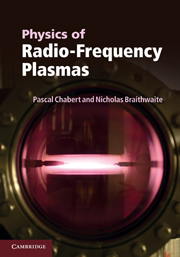Book contents
- Frontmatter
- Contents
- Acknowledgements
- 1 Introduction
- 2 Plasma dynamics and equilibrium
- 3 Bounded plasma
- 4 Radio-frequency sheaths
- 5 Single-frequency capacitively coupled plasmas
- 6 Multi-frequency capacitively coupled plasmas
- 7 Inductively coupled plasmas
- 8 Helicon plasmas
- 9 Real plasmas
- 10 Electrical measurements
- Appendix: Solutions to exercises
- References
- Index
7 - Inductively coupled plasmas
Published online by Cambridge University Press: 04 April 2011
- Frontmatter
- Contents
- Acknowledgements
- 1 Introduction
- 2 Plasma dynamics and equilibrium
- 3 Bounded plasma
- 4 Radio-frequency sheaths
- 5 Single-frequency capacitively coupled plasmas
- 6 Multi-frequency capacitively coupled plasmas
- 7 Inductively coupled plasmas
- 8 Helicon plasmas
- 9 Real plasmas
- 10 Electrical measurements
- Appendix: Solutions to exercises
- References
- Index
Summary
Capacitively coupled plasma reactors have some natural limitations. Although very high-frequency CCPs achieve high plasma density (typically ne ≈ 1017 m−3), this is accompanied by major uniformity problems. Moreover, the ion flux and the ion energy cannot be varied totally independently, even when multiple-frequency excitation is employed. Inductively coupled discharges overcome these limitations to some extent. They are used in plasma processing and for plasma light sources.
Inductive discharges have been known since the end of the nineteenth century. The principle is to induce an RF current in a plasma by driving an RF current in an adjacent coil. From an electromagnetic point of view, the changing magnetic field associated with the coil current induces an electromagnetic field similar to the H-mode studied in the previous chapter. However, the coil is much more efficient than a pair of parallel plates in exciting an H-mode. Interestingly, the coil also couples to the plasma electrostatically, which means that an inductive discharge may also operate in an E-mode and therefore it can experience transitions between E and H-modes. These transitions are usually sharper than in VHF capacitive discharges, with strong hysteresis effects and instabilities when electronegative gases are used.
- Type
- Chapter
- Information
- Physics of Radio-Frequency Plasmas , pp. 219 - 259Publisher: Cambridge University PressPrint publication year: 2011
- 3
- Cited by



